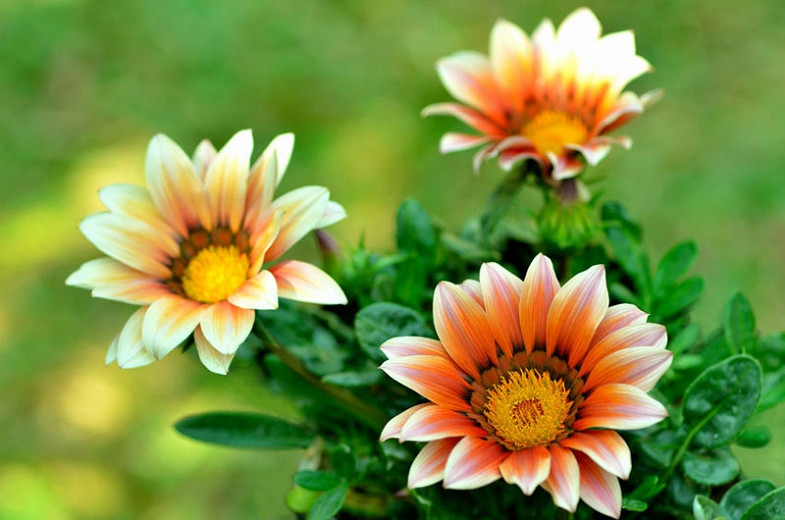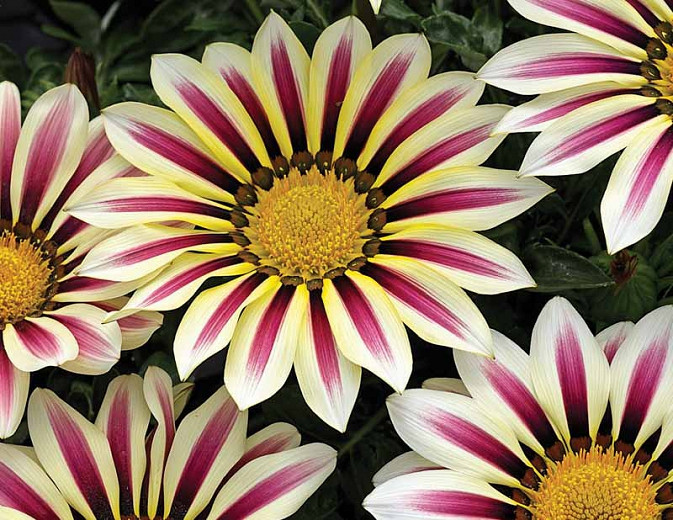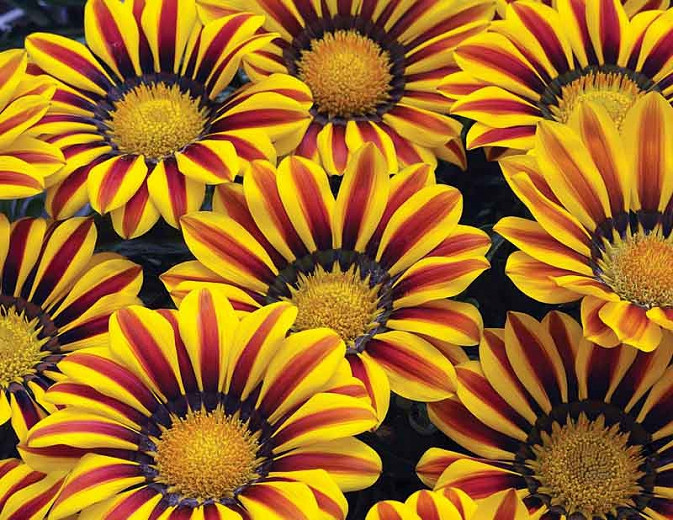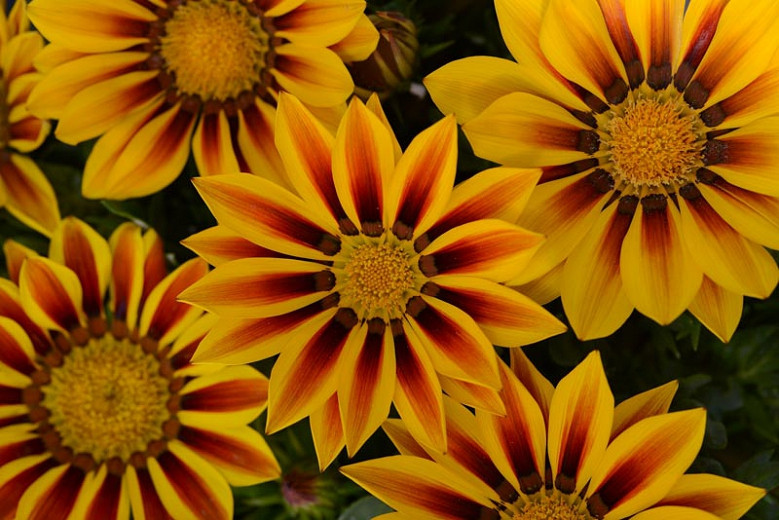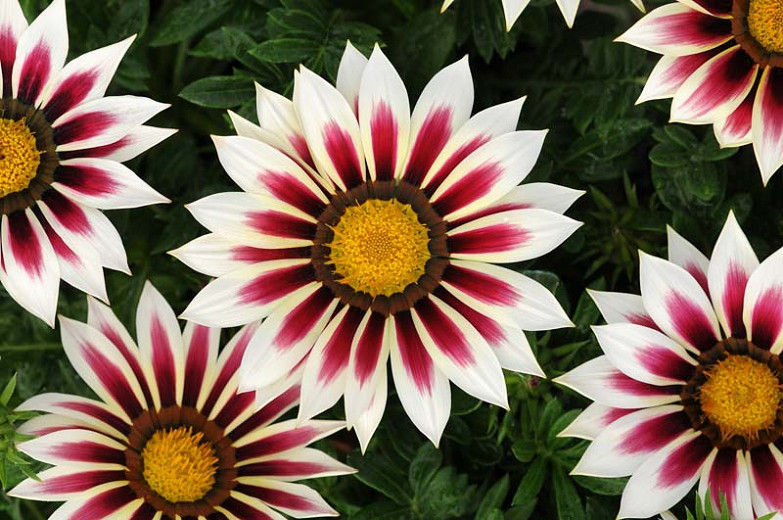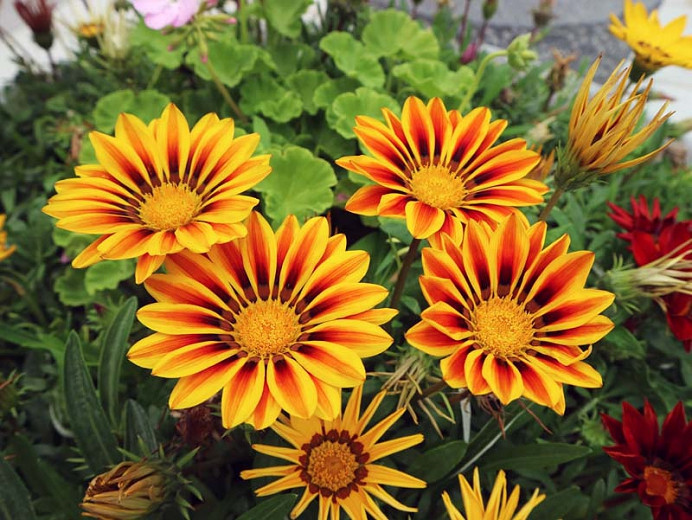Gazania (Treasure Flower)
Native to South Africa, Gazanias (Treasure Flower or African Daisy) are showy tender perennials exhibiting brightly colored daisy-like flowers, up to 4 in. wide (10 cm), over a long blooming season. Ridiculously easy to grow, they tolerate drought, heat, and seacoast conditions, and grow well in most soils. Prized by gardeners for their dazzling colors, Gazanias are ideal plants to add drama to sun-baked sites with dry soil, where other plants would shrivel.
Native to South Africa, Gazanias (Treasure Flower or African Daisy) are showy tender perennials exhibiting brightly colored daisy-like flowers, up to 4 in. wide (10 cm), over a long blooming season. Ridiculously easy to grow, they tolerate drought, heat, and seacoast conditions, and grow well in most soils. Prized by gardeners for their dazzling colors, Gazanias are ideal plants to add drama to sun-baked sites with dry soil, where other plants would shrivel.
- Gazanias belong to the Asteraceae family. They reward us with brilliant flowers in cheerful hues including bright yellow, red, orange, pink, and white. Their petals may be adorned with a dark starburst or a ring of black dots surrounding their golden center. The blooms can be so alluring, they will have you crouching for a closer look.
- Gazania flowers close at night and in cloudy weather. They bloom profusely in late spring and early summer. In mild winter areas, they bloom intermittently through the rest of the year.
- There are 2 main types of Gazanias: clumping and trailing. Clumping Gazenias form a mound of evergreen, usually lobed leaves, dark green above and gray underneath. The flowering stems are 6-10 in. tall (15-25 cm) and bear a wide array of flower colors, with solid or striped colors. Trailing Gazenias grow as tall as the clumping Gazenias, but they spread quickly by long, trailing stems. Their foliage is silvery gray and their blooms are orange, yellow, white, or bronze.
- Gazanias thrive in full sun and prefer sandy, well-drained soils. However, they are not fussy about soils and will tolerate loam and poor soils. Gazanias perform best in hot weather. Drought tolerant, they do not require as much water as other annuals or perennials. Allow the soil to dry out between waterings to avoid root rots or fungal infections.
- Gazanias are virtually disease and pest free when grown in adequate conditions. Watch for aphids if overwintered indoors
- Deadhead spent flowers to encourage flowering.
- Propagate by seed, cuttings. Start the seeds indoors 6 to 8 weeks before the last spring frost date, or scatter the seeds where desired outdoors after frost danger has passed. Make basal cuttings in late summer or early fall.
- Gazanias are versatile landscape plants. Clumping Gazanias can be used as edging along sunny paths, or to add color to rock gardens, Mediterranean or xeriscape gardens. They could act as pretty fillers between young shrubs. Trailing Gazenias are useful as ground covers and spectacular when massed on banks and slopes where they will help control soil erosion. Their trailing stems and sparkling blooms make them terrific additions to hanging baskets, and containers, over the top of walls where they will cascade gracefully down, creating a waterfall effect.
Guide Information
| Hardiness | 8 – 11 |
|---|---|
| Heat Zones | 8 – 10 |
| Climate Zones | 8, 9, 10, 11, 12, 13, 14, 15, 16, 17, 18, 19, 20, 21, 22, 23, 24, H1, H2 |
| Plant Type | Perennials |
| Plant Family | Gazania |
| Exposure | Full Sun |
| Season of Interest | Spring (Late)Summer (Early) |
| Height | 1' – 2' (30cm – 60cm) |
| Water Needs | Low, Average |
| Maintenance | Low |
| Soil Type | Loam, Sand |
| Soil pH | Acid, Alkaline, Neutral |
| Soil Drainage | Moist but Well-Drained, Well-Drained |
| Characteristics | Showy |
| Tolerance | Drought, Dry Soil, Salt |
| Attracts | Butterflies |
| Landscaping Ideas | Banks and Slopes, Beds and Borders, Edging, Ground Covers, Hanging Baskets, Pathways, Patio and Containers |
| Garden Styles | Coastal Garden, Gravel and Rock Garden, Informal and Cottage, Mediterranean Garden |

